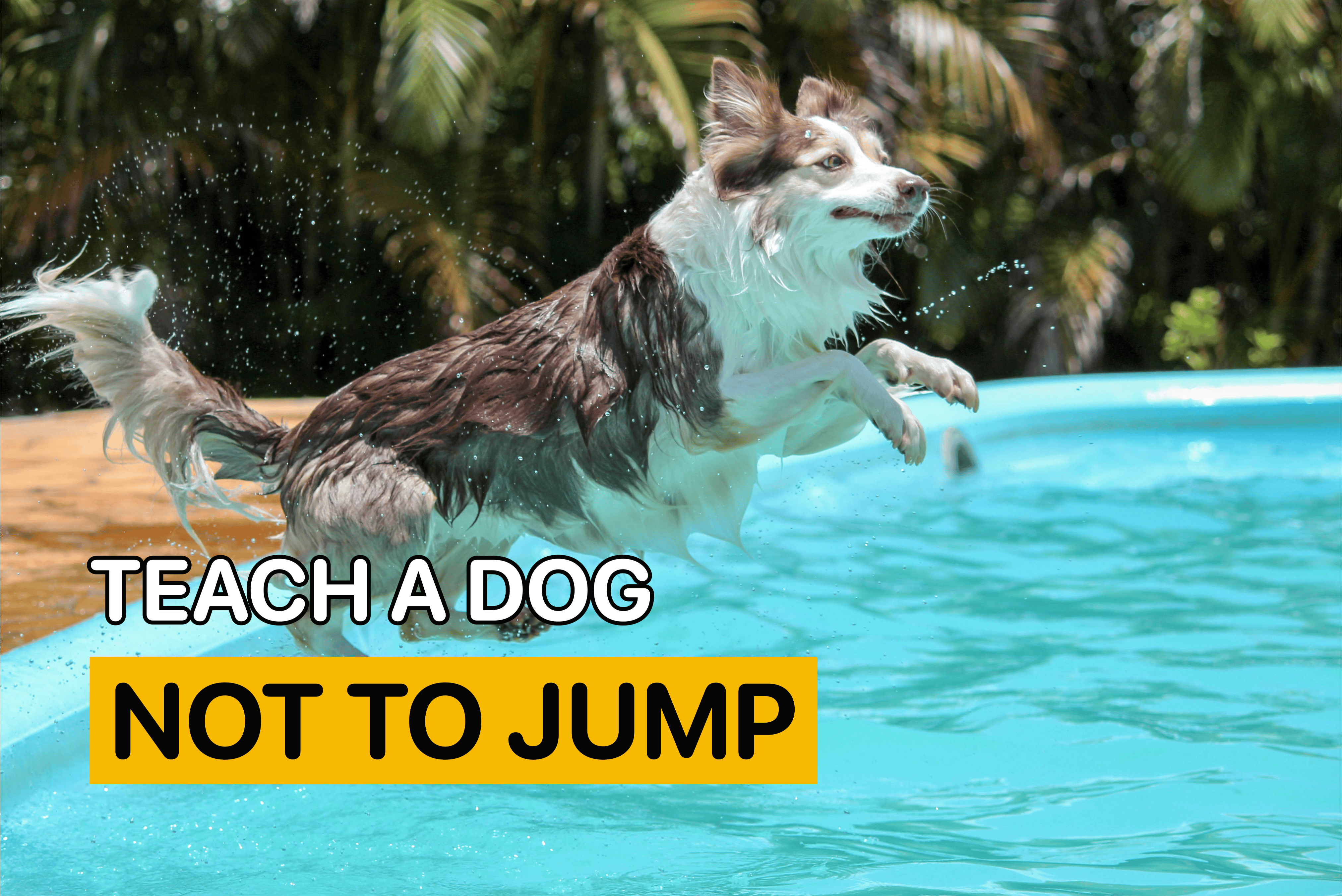Can All Dogs Swim? 10 Steps to Teach your Dog to Swim

By
Woofz Team Updated on |Reviewed by
Karen PiwinskiAs a pet parent, you can assume that dogs are natural swimmers. Indeed, most breeds find swimming both enjoyable and fun, and they rarely can resist the temptation if they walk past a lake or a pond. However, some dogs are built differently and due to differences in their skeletal structure and temperament, might be less fond of spending time in water.
Keep reading to find out more about teaching a dog to swim. We offer you expert-verified advice on how to help your pooch swim like a pro.
Do All Dogs Know How to Swim?
If you ask a passerby: Can all dogs swim? You’re likely to hear yes.
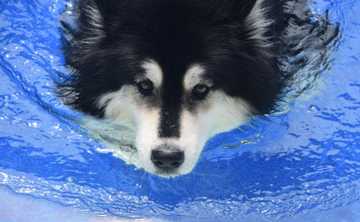
However, this is far from reality, and the idea that all dogs know how to swim and enjoy doing so is a common misconception about canines. Some breeds are more drawn to this activity, and we will explain why.
Breed differences
Historically, humans started to breed dogs to meet specific requirements and help fulfil certain tasks (like hunting, herding or protection). Some breeds that are bred to swim have names that include the word “water,” such as Portuguese Water Dog, Irish Water Spaniel, etc.

These breeds were developed to work in the water and help bring in prey from water sources. They’re excellent swimmers with a set of physical characteristics that allow them to move freely in the water. So, if your furry companion can’t get enough of fooling around in the pool, it’s probably in their DNA.
Brachycephalic breeds like frenchies and english bulldogs have trouble swimming due to their limited ability to breathe.
Physical characteristics
As we’ve already mentioned, whether your pooch enjoys swimming or steers away from it largely depends on their genetic makeup. Canines who love to swim possess some physical characteristics that make staying afloat easier.
Dogs that are good at swimming typically have:
- Webbed feet
- Well-developed muscles
- Water-resistant coats
- Sufficient levels of body fat.
Individual temperament
Dogs are known for their larger-than-life personalities, and just like humans, they vary significantly from individual to individual. Some are more active, adventurous, and willing to take risks, while others are more cautious and prefer to avoid new experiences.

**Another aspect **that can influence how much interest your furry family member has in water is their life experience. For instance, early exposure is beneficial and contributes to a love for swimming. Drowning incidents, being forced to swim, or other negative experiences can dishearten a dog from stepping into the water.
How to Teach Your Dog to Swim in 10 Steps
1. Start in safe and shallow water
To avoid forming negative associations with water, it’s essential to take it slow and introduce your pooch to a lake or a swimming pool gradually.
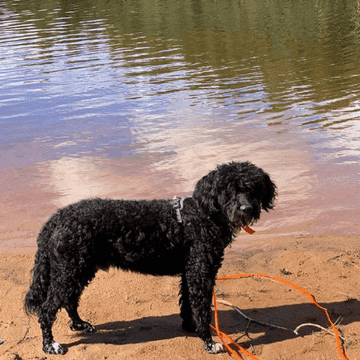
Find a location with a gentle slope where your pet can step into the water and get used to the new feeling. Choose shallow water with no strong currents, so that your dog feels safe in it.
2. Take a gradual approach to training
Remember that swimming can be a stressful experience, especially for those dogs who have had previous negative experiences. Allow them to adjust at their own pace and don’t rush them to get into the water. Monitor their reaction and encourage them to go into deeper water if you see they tolerate it well.
3. Use positive reinforcement
Dogs learn best when they receive praise and positive reinforcement.
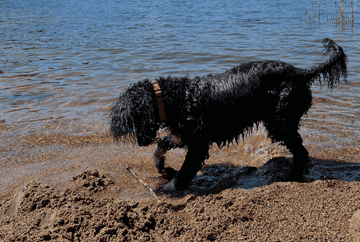
Stock up on your pooch’s favorite treats and bring toys they like to use during the process of learning to swim. Praise and reward your companion for stepping into the water and making attempts to paddle.
4. Offer support
Be there for your dog to provide them with the needed support during the training.
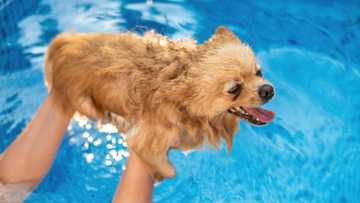
Dogs that are prone to getting frightened or running away will benefit from a leash. If you see your companion is scared, place your hand under their belly for extra support or use other means to make them feel more at ease.
Dogs can benefit from a life jacket (available online and in pet stores), which can help both them and you, as the owner, feel more comfortable.
5. Encourage paddling
You can help your pooch understand better how to stay afloat and move in the water by encouraging paddling. You can support their midsection if you see signs of hesitation or lack of confidence. Then, use their favorite toy or your hand to show them the direction in which they must move.
Keep in mind that using treats or a toy at this stage can sometimes distract them from paddling. They may forget to use their hind legs, which can cause them to sink.
6. Keep it fun
One way to encourage swimming in canines is to make it fun and engaging.
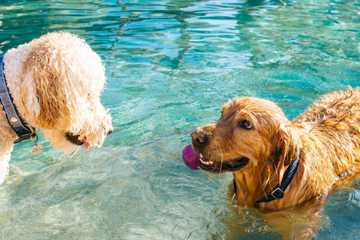
Spending quality time with your pooch in a swimming pool is also excellent for bonding and physical exercise. You can play fetch or tug-of-war, use a sprinkler, splash around, or even set up a small pool just for them to cool off in.
7. Be patient and consistent
Since some dogs are fearful of water, you have to remain patient with them. It’s better to arrange short swimming lessons and repeat them regularly than force your dog into the water and scare them..
8. End on a positive note
Forming positive associations and teaching them to enjoy swimming are fundamental. Besides praise and reward during the training itself, you can try finishing each session with an entertaining activity. Such a simple step can make your dog look forward to the next time you practice swimming.
9. Consider a dog life vest
Using a life vest for canines that lack actual swimming experience can be a game-changer.

It provides buoyancy and extra support to build confidence for swimming in deeper water. They also help them stay afloat and encourage them to use all four legs while swimming, which contributes to developing proper swimming technique.
10. Watch for signs of stress
Swimming can be stressful for novices. It’s essential to make swimming lessons as pleasurable for your companion as possible. You must monitor their reactions and modify your training plan if you see any signs of stress.
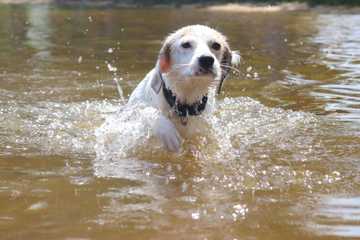
A stressed dog can start:
- Panting excessively
- Licking lips
- Trembling
- Yawning
- Pinning their ears close to their head
- Struggling to stay afloat.
If you notice any of these signs, consider stopping the swimming sessions, making them shorter, and adding more positive reinforcement.
How Long Can a Dog Swim? And Other Water Safety Tips
The time your dog can spend swimming depends on several factors, such as their age, breed, overall fitness, and weather conditions.
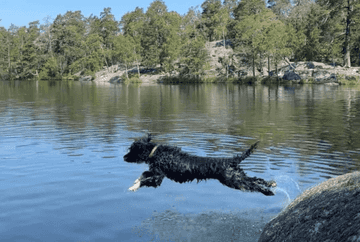
A healthy adult dog can swim safely for around 30 minutes or more, depending on their endurance level. Overweight canines or brachycephalic breeds can get tired quickly, so it’s a good idea to reduce their swimming lessons to 5–20 minutes, with support.
Water safety tips to consider:
-
Water quality: Ensure the water you let your pet swim in is clean, with no Algae Blooms and a minimal amount of debris. Avoid stagnant water as it increases the risks of bacterial infections and parasite invasion.
-
Constant supervision: Monitor your dog all the time, especially if they aren’t confident swimmers. Choose areas with minimal waves and currents, and ensure the water temperature is not too cold.
-
Life jacket: Puppies, senior dogs, and inexperienced swimmers will benefit from a life jacket. It provides a canine with extra support, helps keep the body in a horizontal position, and encourages them to paddle using four legs. Dogs that are scared of swimming may also feel more confident with extra help from a life vest or other safety gear.
-
Know your dog's limits: Swimming and water play can exhaust your dog. A pet parent must check their reaction and never force them to swim if they’re tired or stressed in the water. Encourage them to take breaks to rest and restore their energy levels.
-
Pool safety: Install a fence around the pool to prevent accidental falls or swimming without your supervision.
-
Rinse off after swimming: Rinse your pooch’s coat after swimming to remove salt, chlorine, and any other elements that can be harmful to their fur and skin.
Wrap Up
Swimming is a great summer activity for dogs that helps them stay active and spend quality time with their owners. Not all dogs are naturally good at swimming, though. If you see your pooch needs extra help to learn how to swim, introduce them to it gradually, allowing plenty of time to adjust and using positive reinforcement. Ensure you follow water safety tips to keep swimming not only fun but also risk-free.



